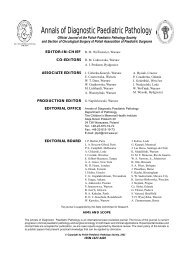tumor in the light of the revised SIOP-01 classification
tumor in the light of the revised SIOP-01 classification
tumor in the light of the revised SIOP-01 classification
Create successful ePaper yourself
Turn your PDF publications into a flip-book with our unique Google optimized e-Paper software.
Annals <strong>of</strong> Diagnostic Paediatric Pathology 2006, 10 (3–4): 109–113<br />
© Copyright by Polish Paediatric Pathology Society Annals <strong>of</strong><br />
The study on <strong>the</strong> pathogenesis <strong>of</strong> <strong>in</strong>test<strong>in</strong>al dismotility<br />
and malabsorbtion <strong>in</strong> gastroschisis on experimental model<br />
– chicken embryo<br />
Hanna Bu³hak-Guz 1 , Reg<strong>in</strong>a Cybulska 2 , Ewa Czichos 3 , Tomasz Krawczyk 3 ,<br />
Andrzej Kulig 3 , Andrzej Chilarski 1<br />
1 Department <strong>of</strong> Pediatric Surgery and Urology<br />
3 Departament <strong>of</strong> Cl<strong>in</strong>ical Pathomorphology<br />
Polish Mo<strong>the</strong>rs's Health Institute<br />
Lodz, Poland<br />
2 Institute <strong>of</strong> Histology and Embriology <strong>of</strong> Agricultural Academy<br />
Lubl<strong>in</strong>, Poland<br />
Introduction<br />
Abstract<br />
In gastroschisis (G) bowel loops protrude through a narrow,<br />
paraumbilical defect <strong>in</strong> <strong>the</strong> abdom<strong>in</strong>al wall <strong>of</strong> <strong>the</strong> fetus <strong>in</strong>to<br />
<strong>the</strong> amniotic cavity and float freely <strong>in</strong> <strong>the</strong> amniotic fluid<br />
exposed to its irritat<strong>in</strong>g activity lead<strong>in</strong>g to aseptic perivisceritis.<br />
Impairment <strong>of</strong> peristalsis <strong>of</strong> <strong>the</strong> bowels and food malab-<br />
Address for correspondence<br />
Gastroschisis (G) is a congenital defect <strong>of</strong> <strong>the</strong> abdom<strong>in</strong>al wall characterized by translocation <strong>of</strong> <strong>in</strong>test<strong>in</strong>al<br />
loops outside <strong>the</strong> abdom<strong>in</strong>al cavity dur<strong>in</strong>g fetal life through a defect usually located on <strong>the</strong> right side <strong>of</strong> <strong>the</strong><br />
umbilical cord. Translocated fragment <strong>of</strong> <strong>in</strong>test<strong>in</strong>es <strong>in</strong> <strong>the</strong> extraembryonic cavity is exposed to direct contact<br />
with <strong>the</strong> amniotic fluid (AF) and excrements conta<strong>in</strong>ed <strong>in</strong> it (ur<strong>in</strong>e and meconium). The abnormalities <strong>of</strong><br />
<strong>in</strong>test<strong>in</strong>al function vary <strong>in</strong> <strong>in</strong>tensity and <strong>the</strong> question arises whe<strong>the</strong>r dysfunction <strong>of</strong> <strong>the</strong> alimentary tract<br />
results form morphological changes <strong>in</strong> <strong>the</strong> whole <strong>in</strong>test<strong>in</strong>al wall or only <strong>in</strong> <strong>the</strong> translocated loops. The<br />
designed experiments are aimed to answer this question, and also to determ<strong>in</strong>e <strong>the</strong> character and extension<br />
<strong>of</strong> changes <strong>in</strong> <strong>the</strong> abdom<strong>in</strong>al wall. The study consisted <strong>of</strong> an experimental creation <strong>of</strong> G on chicken embryos<br />
model and <strong>the</strong> subsequent comparison <strong>of</strong> <strong>the</strong> histopathological picture <strong>of</strong> <strong>the</strong> bowel wall <strong>of</strong> <strong>the</strong><br />
<strong>in</strong>traabdom<strong>in</strong>al loops versus <strong>the</strong> exteriorized ones. The histopathological exam<strong>in</strong>ation revealed lesions <strong>in</strong><br />
<strong>the</strong> eviscerated loops (exposed to AF activity) <strong>in</strong>clud<strong>in</strong>g <strong>the</strong> congestion <strong>of</strong> <strong>the</strong> <strong>in</strong>test<strong>in</strong>al villi, accumulation<br />
<strong>of</strong> erythrocytes <strong>in</strong> <strong>the</strong> villus vessels, concentration <strong>of</strong> <strong>in</strong>flammatory small-round cells <strong>in</strong> <strong>the</strong> serosa. Our<br />
results showed that: 1) <strong>the</strong> experimental studies on G showed <strong>the</strong> differences <strong>in</strong> <strong>the</strong> histopathological picture<br />
<strong>of</strong> <strong>the</strong> eviscerated bowel loops as compared to <strong>the</strong> <strong>in</strong>traabdom<strong>in</strong>al ones, 2) lesions <strong>in</strong> <strong>the</strong> <strong>in</strong>test<strong>in</strong>al<br />
epi<strong>the</strong>lium (<strong>the</strong> congestion <strong>of</strong> <strong>the</strong> villi) result from <strong>the</strong> bowel constriction and can be responsible for<br />
malabsorption <strong>in</strong> G patients, 3) <strong>in</strong>flammatory lesions <strong>in</strong> <strong>the</strong> serosa are caused by <strong>the</strong> irritat<strong>in</strong>g <strong>in</strong>fluence <strong>of</strong><br />
<strong>the</strong> AF and can be responsible for postnatal peristalsis impairment.<br />
Key words: chicken embryo, gastroschisis, <strong>in</strong>test<strong>in</strong>al damage<br />
Hanna Bu³hak-Guz Phone: + 48 42 2712136<br />
Department <strong>of</strong> Pediatric Surgery and Urology E-mail: hbulhak@wp.pl<br />
Polish Mo<strong>the</strong>rs's Health Institute<br />
Rzgowska St. 281/289<br />
93-338 Lodz, Poland<br />
Diagnostic<br />
Paediatric<br />
Pathology<br />
sorption occurr<strong>in</strong>g <strong>in</strong> newborns treated for G are a serious cl<strong>in</strong>ical<br />
problem and have an <strong>in</strong>fluence on <strong>the</strong> method, length<br />
and costs <strong>of</strong> <strong>the</strong> treatment [17].<br />
In relation to <strong>the</strong> occur<strong>in</strong>g bowel malfunction <strong>of</strong> various<br />
severity, <strong>the</strong> question arises whe<strong>the</strong>r <strong>the</strong> alimentary<br />
tract disfunction results from <strong>the</strong> morphological changes <strong>in</strong><br />
<strong>the</strong> bowel wall <strong>in</strong> <strong>the</strong> eviscerated loops only or perhaps <strong>the</strong>y

















